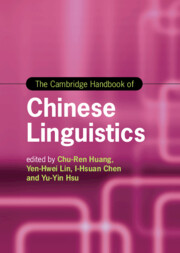Book contents
- The Cambridge Handbook of Chinese Linguistics
- Cambridge Handbooks In Language and Linguistics
- The Cambridge Handbook of Chinese Linguistics
- Copyright page
- Contents
- Figures
- Tables
- Contributors
- Acknowledgments
- Part One Writing System/Neuro-cognitive Processing of Chinese
- Part Two Morpho-lexical Issues in Chinese
- Part Three Phonetic-phonological Issues in Chinese
- 11 The Morphophonology of Chinese Affixation
- 12 Mandarin Chinese Syllable Structure and Phonological Similarity
- 13 Tonal Processes Defined as Articulatory-based Contextual Tonal Variation
- 14 Tonal Processes Defined as Tone Sandhi
- 15 Tonal Processes Conditioned by Morphosyntax
- 16 Tone and Intonation
- 17 Evidence for Stress and Metrical Structure in Chinese
- 18 Perceptual Normalization of Lexical Tones
- Part Four Syntax-semantics, Pragmatics, and Discourse Issues
- Index
- References
15 - Tonal Processes Conditioned by Morphosyntax
from Part Three - Phonetic-phonological Issues in Chinese
Published online by Cambridge University Press: 04 August 2022
- The Cambridge Handbook of Chinese Linguistics
- Cambridge Handbooks In Language and Linguistics
- The Cambridge Handbook of Chinese Linguistics
- Copyright page
- Contents
- Figures
- Tables
- Contributors
- Acknowledgments
- Part One Writing System/Neuro-cognitive Processing of Chinese
- Part Two Morpho-lexical Issues in Chinese
- Part Three Phonetic-phonological Issues in Chinese
- 11 The Morphophonology of Chinese Affixation
- 12 Mandarin Chinese Syllable Structure and Phonological Similarity
- 13 Tonal Processes Defined as Articulatory-based Contextual Tonal Variation
- 14 Tonal Processes Defined as Tone Sandhi
- 15 Tonal Processes Conditioned by Morphosyntax
- 16 Tone and Intonation
- 17 Evidence for Stress and Metrical Structure in Chinese
- 18 Perceptual Normalization of Lexical Tones
- Part Four Syntax-semantics, Pragmatics, and Discourse Issues
- Index
- References
Summary
Tone in Chinese languages is distinct in two aspects: (i) the complexity in the tonal make-up and (ii) widespread sandhi. The former is often attributed to underlying complexity in tonal inventories and the latter to triggers immediately adjacent to the sandhi site. Morphosyntax, though highly relevant, is often left unarticulated in the description of tonal inventories and processes. This chapter unravels four major aspects in which morphosyntax condition tonal processes (a) the licensing and/or generation of tonal contours, (b) the neutralization of tone, (c) the triggering and blocking of sandhi; and (d) the impact on tonal prosody. While phonological patterns in other languages are sensitive to the word- and post-lexical levels divide, it is the structural constituency that is often more relevant than syntactic category in Chinese tonal processes. Lest one overstates the power of morphosyntax, note also that morphosyntactic conditioning of tonal processes is likely mediated through alignment and interface with prosody structure. Thus morphosyntax plays not a deterministic role, but a substantially contributive one in the intricacies of tonal processes in Chinese.
- Type
- Chapter
- Information
- The Cambridge Handbook of Chinese Linguistics , pp. 313 - 335Publisher: Cambridge University PressPrint publication year: 2022
References
- 1
- Cited by



